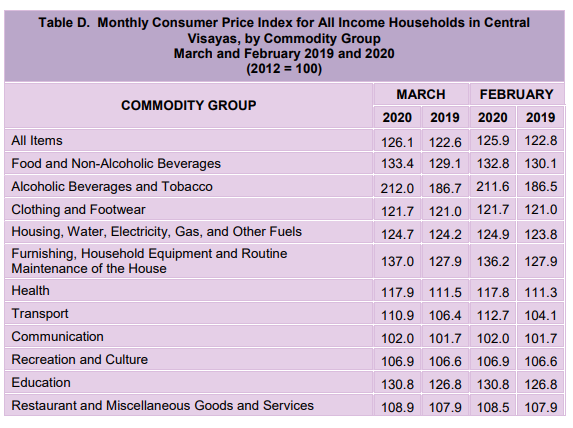Starting March 2018, the Philippine Statistics Authority (PSA) released the rebased CPI series as announced in the press release number 2018-031 dated 22 February 2018. The CPI series for July 2018 onwards shall be 2012-based.
Year on Year Inflation rate in Central Visayas was recorded at 2.9 percent
Inflation in Central Visayas for March 2020 was further accelerated to 2.9 percent from 2.5 percent in the previous month. Inflation in March 2019 was lower at 2.2 (Table A).

The uptrend of the inflation in March 2020 was primarily due to Food and Non-Alcoholic Beverages whose index rose at an annual rate at 3.3 percent.
Inflation in the following commodity groups were higher during the month:
Alcoholic Beverages and Tobacco, 13.6%;
Furnishing, Household Equipment and Routine Maintenance of the House; 7.1%;
Restaurant and Miscellaneous Goods and Services, 0.9%
Inflation in the following commodity groups were lower during the month:
Housing, Water, Electricity, Gas, and Other Fuels, 0.4%
Health, 5.7%;
Transport, 4.2%;
Constant inflation from the previous month were carried over by the following commodity groups:
Clothing and Footwear, 0.6%;
Communication, 0.3%;
Recreation and Culture, 0.3%;
Education, 3.2%;
March 2020 CPI in Central Visayas was recorded 126.1
- March 2020 CPI in Central Visayas was recorded at 126.1. An increased was noted from the previous month which was at 125.9. There was an increasing movement of the CPI from March 2019 to March 2020 except for the months of October 2019 and February 2020 which posted a dropped in the movement of CPI.
- Higher annual rate was noted in the indices of each commodity group from February and March 2020 compared to February and March 2019 (Table D).

Purchasing Power of Peso (PPP) was recorded at 0.79 in March 2020
Purchasing Power of Peso in Central Visayas remained at 0.79 in March 2020. From 0.82 in March 2019, PPP exhibited a downtrend movement and posted a decreased at 0.81 in April 2019 to October 2019. In November and December 2019, PPP further declined to 0.80 and continued to decline in January 2020 to March 2020 at a constant rate of 0.79.
TECHNICAL NOTES
The Philippine Statistics Authority generates and announces the monthly Consumer Price Index (CPI) based on a nationwide survey of prices for a given basket of goods and services. Two important indicators, the inflation rate and purchasing power of the peso (PPP), are derived from the CPI which are important in monitoring price stability and the value of the country’s currency.
The CPI is an indicator of the change in the average retail prices of a fixed basket of goods and services commonly purchased by households relative to a base year.
Retail Price is the price at which a commodity is sold for spot in small quantities for consumption.
Base Period/Base Year is the period, usually a year, at which the index number is set to 100. It is the reference point of the index number series.
Market Basket is a term used to refer to a sample of goods and services that are commonly purchased and bought by an average Filipino household.
Weight is a value attached to a commodity or ground of commodities to indicate the relative importance of that commodity or group of commodities in the market basket.
Inflation Rate is equivalent to a decline in the purchasing power of the peso. It is the change in the CPI over a specific period of time (usually a month or a year). That is, where:
CPI1 - is the CPI in the previous period
CPI2 - is the CPI in the current period
The Purchasing Power of the Peso (PPP) is a measure of the real value of the peso in a given period relative to a chosen reference period. It is computed by getting the reciprocal of the CPI and multiplying the result by 100. That is,
Headline Inflation is the rate of change in the weighted average prices of all goods and services in the CPI basket.
Approved by:
(SDG.) ARIEL E. FLORENDO
Regional Director

